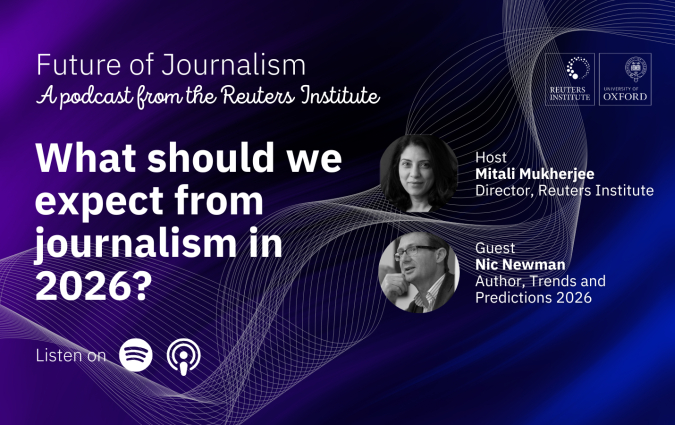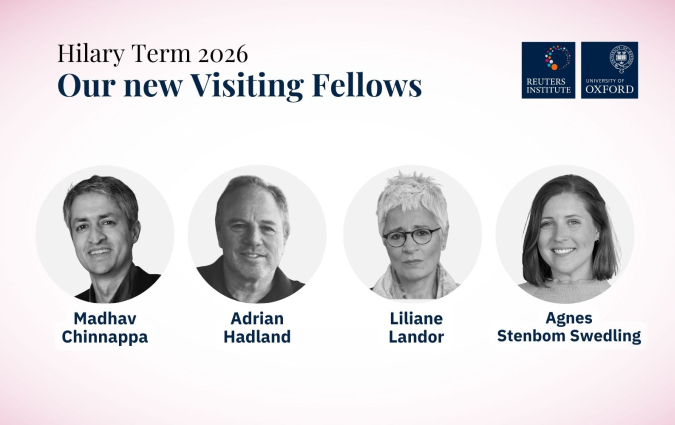Five things news media can do to respond to consistent news avoidance

A woman passes by a newspaper stand in Lisbon in November 2023. REUTERS/Pedro Nunes
This piece is an excerpt of Avoiding the News, a book authored by Benjamin Toff, Ruth Palmer and Rasmus K. Nielsen. The book is based on interviews in Spain, the UK and the US as well as extensive survey data, and was published in December 2023.
In many countries across the world, a significant number of people consistently avoid the news, and more broadly, news consumption is declining, interest in news is down, and more occasional selective news avoidance growing. In a new book, we use data from surveys as well as well over a hundred interviews with consistent news avoiders in the UK, Spain, and the US to understand why and how people circumvent news. We also identify five examples of research-backed steps that journalists and editors could take if they want to address the issue of news avoidance.
1. Responding to how news feels.
Let us start with news content and the way it is presented. News avoidance is not only a response to content. But make no mistake: content is still a big part of the problem. When so many people explain their news avoidance by saying, “it’s not me, it’s news,” a first response should be to look closely at the coverage that turns them off.
Many people – and not just consistent news avoiders – say that news is depressing, irrelevant, unintelligible, and that there isn’t anything they can do about the problems they see in the news anyway. These complaints are a starting point for meeting people where they are culturally. If our goal is to address consistent news avoidance, it fundamentally does not matter whether these beliefs are fair or accurate. What matters is the social fact that millions of people hold these views, and that these preconceptions lead some to systematically avoid the news, and many others to approach it only hesitantly.
It does not have to be this way. A news organisation that wanted to could say, “we hear you.” It could differentiate itself from an abundance of relentlessly depressing news-as-usual by stating clearly and explicitly, “we want to be different,” and telling people –over time, showing people – that they are not afraid to lead with news that is uplifting, closer to people’s lived experience, presented in more accessible ways, and focused on things they can influence.
We are aware that calling for more accessible news may trigger some well-worn complaints from self-styled intellectuals and media critics, such as concerns about the “dumbing down” of news. But the core of the matter here is not intelligence, it is intelligibility. Political journalism, especially, tends to make assumptions about what audiences know about political actors and processes that are impossible for all but the most dedicated news lovers to live up to. This results in coverage that is about as meaningful for many potential news consumers as sports journalism of a specialised game would be for those who have little conception of the stakes, norms, or rules – only it is not a game.
Another likely objection is that integrating more constructive, down-to-earth, and solutions-based approaches in editorial routines risks reducing otherwise serious, hard-hitting news to feel-good puff pieces and superficial service journalism.
It is hard to take this objection seriously. Only those who refuse to contemplate the idea of change can't see that journalism already does plenty of this “puffy” stuff, but it is primarily focused on the famous, powerful, and/or rich. It is rarely what elite news organisations lead with at the top of their apps or websites, but it is in plentiful supply, at least for privileged audiences. Surely it can't be perfectly compatible with journalism’s core values to have plenty of news dedicated to expensive cars, investing, private education, real estate, and “high” culture aimed at the well-to-do, or a weekly supplement called How to Spend It full of service journalism and actionable content for the most affluent (and lucrative ads to boot), but antithetical to those same values to help everybody else live their lives.
Actionability seems especially important here. Too often news avoiders we interviewed felt that the “how this could affect you and what you can do about it” statement in most news was implied or missing, which left them trying to fill in that gap on their own. And without that link to their lives clearly articulated, many news avoiders saw little reason to consume news that would just upset them.
Structuring stories explicitly to highlight, rather than to bury or elide, how those stories could directly affect audience members’ lives and how they might respond would counterbalance that feeling that news is pointlessly negative. It would also address frequently invoked folk theories that much news, especially about politics, has no bearing on ordinary peoples’ lives.
2. Taking communities and identities seriously.
Those who want to engage news avoiders need to keep in mind that the meaning and value of news to individual citizens is deeply relational, tied in with their identities and the communities to which they belong.
In this regard, efforts to address consistent news avoidance need to begin by systematically examining whether media organisations do in fact serve those groups most likely to avoid the news (younger people, women, and less privileged parts of the public) as well as journalists would like to claim. Making it a goal to represent, reflect, and respect groups that have been poorly served historically by the news will require trying to understand these specific publics better – not what they click on or how much time they spend on a web page, but their daily routines, priorities, and broader beliefs about how consuming news directly from news sources stacks up against other alternatives available to them.
Research has long shown that a sense of community helps enhance the value of almost any media practice, from romance reading to fan fiction to online gaming. Encouraging and cultivating a sense of community is also central to other long-standing practices including community organising, political mobilisation, and religious proselytising, just as it is to much of today’s “creator culture.”
Consistent with that, our findings point to the importance of community in helping people to maintain a news habit, and we found that even the most hardened news avoiders usually conceded that there were some social benefits to being informed about news. They often said they wished they could participate in conversations and even games that required knowledge of current events and felt people who did so came across as smart, cultured, and simply well-prepared in social situations (at least when they didn’t seem pompous and ridiculous).
We therefore believe that a good way to help people see more value in news is to try to emphasise the social benefits of news use and to foster new and more inclusive news communities where few or none exist.
Journalists and news media can't travel back in time to change news avoiders’ childhood socialisation, but they can work to make news consumption a more sociable experience in the present. Up to this point, journalism has, with some exceptions, not engaged with this idea of community building around news consumption.
Some marginal experiments aside, the dominant approach is still “we publish, you read,” with limited interaction with readers’ comments and maybe some social media debate. Outside-the-box interventions that emphasise news’s social benefits, especially those that cultivate and increase the visibility of news communities and the wider benefits of news use, might range from outward displays of news consumption (such as lifestyle branding used in membership drives) to fostering book club-like news-reading and news-viewing groups, which could also help with creating and maintaining news communities.
The building of news communities dovetails nicely with the idea of making news more actionable. More privileged audiences already tend to be embedded in news communities that provide a built-in sense of an action context. But many people do not. Journalists could try to show people how and where they can change the world by taking action – on their own, or with like-minded others.
To be effective, these approaches would need to be tailored to different kinds of groups. There is still a tendency for many news organisations to apply one-size-fits-all approaches that worked in a low-choice environment dominated by a few mass media but are unlikely to work in a high-choice environment where even more media use is differentiated along social lines and communities of interest. This will be a challenge.
We also recognise that approaches aimed at playing up social benefits and community aspects of news are unlikely to change the minds overnight of news avoiders who do not trust news or have other complaints about news content. (Many of our interviewees felt media organisations would do anything to sell a story, were intertwined with partisan political interests, and led with opinion rather than factual reporting; if journalists think they are wrong, they need to convince them otherwise.)
However, emphasising social benefits to news use could help to counter-balance some of the costs and downsides that news avoiders associate with news consumption. That is especially important for news avoiders who have never formed a news consumption habit or seen the point of dedicating time to it.
Again, before the idea of playing up social benefits of news communities is rejected as incompatible with everything that journalism stands for, it is worth pointing out that many news media already do versions of this in their service journalism – though again, almost invariably, only for the most affluent consumers or those most narrowly tied to their commercial interests.
They curate bespoke LinkedIn groups for readers with common interests, for example, and woo them with consumer product reviews and travel sections linked to affiliate fee and advertising revenue streams. In those and so many other ways news media already tend to tell elite audiences that they matter: they provide a sense of belonging and efficacy. Surely it is possible for them to do the same for other parts of the public.
The historical roots of journalism include many examples of work that foregrounded people’s agency, for example, as part of the feminist movement, the labor movement, and the civil rights movement. Ensuring all kinds of people feel their identity is reflected and valued in news – indeed that news can empower them to take meaningful action – is clearly not impossible.
3. Packaging and delivering content for consistent news avoiders.
Many news avoiders we interviewed said they felt news was too time-consuming, a poor fit with daily routines, and incompatible with their caretaking responsibilities at home. These are also actionable concerns.
Beyond the editorial changes discussed above, even just packaging existing reporting differently for different audiences could help. Simple summary pieces to accompany longer in-depth pieces could better serve different people’s needs. Some upmarket brands take pride in their “smart brevity.” The frequency with which our interviewees said they struggled to understand news when they came across it highlights the unmet need for “simple brevity” for those who do not already consider themselves in the know.
Current content and formats are not meeting this need.
On the content side, part of the problem involves assumptions made about people’s familiarity with actors and processes – in politics or elsewhere as noted above – but on a more basic level this is a problem of language. The US Department of Education estimates that more than half of adult Americans have a prose literacy level below 6th grade, but much news seems to assume high-school-level, if not college-level proficiency, as well as contextual knowledge.
Online widgets, which some news organisations are experimenting with, can provide background and context for those who are new to a story or issue.
Personalisation, at least in principle, provides further opportunities. Loyal returning users may be perfectly happy with incremental updates on ongoing stories they are assumed to be following. But that is not the right starting point for everyone. In the future personalisation might offer not just different story selections, but stories matched to individual users’ interests and prior levels of background knowledge. (After all, Spotify does not offer the same front page of their app to all users; most news organizations still do.)
Delivery also matters. Editorial innovation is often heavily focused on what news organisations offer on their own websites and apps. That is understandable. These are the channels where news organisations have the most control (and they are the most valuable for commercial organisations). But the reality is that most consistent news avoiders, and many other people, rarely if ever come to the websites and apps of news media.
So, as complicated and fraught as the relationship between publishers and platforms remains, reaching the least engaged members of the public will require continued effort to meet them where they are in terms of infrastructures, and that will be on social media, messaging applications, video platforms, and the like.
The way we see it, when people say that they believe the news will “find them,” news organisations have two options: they can respond by saying “no, it won’t, you’ll have to find it on our websites and apps” (which our research shows is highly unlikely), or they can respond by maximising the chance that it will find them. Each option reflects different priorities.
Likewise, when people say that the information is “out there,” news organisations can respond by saying “no, it isn’t, which is why you should subscribe and be able to access our archive” (which, again, our research suggests that consistent news avoiders are very unlikely to do), or by maximising the chance that people will find credible news when searching. Again, each option reflects different priorities.
If meeting people where they are in terms of delivery and infrastructure is an unappetising prospect for upmarket commercial news providers focused on developing their own on-site audience, it may be particularly important for public service and non-profit media to think about how they can do so on different platforms and thereby avoid just super-serving already well-served, privileged audiences.
4. News media literacy and communicating the value of journalism.
For a profession and industry almost entirely premised on communications, journalism and the news media can come across as curiously inept at getting the point of their own work across. News, at its best, offers real value to people, and real social benefits for communities and society at large. But it is important to explain and advertise this.
All the innovations we have discussed so far, and others that news organisations are already experimenting with, will only appeal to news avoiders or other potential news audiences if people know about them. Our interviewees sometimes said they might consume more news if only it came in a more digestible format or covered X, Y, or Z, options that we knew existed already, but they did not.
If news organisations develop ways to deliver news that are efficient, digestible, and foreground why people should care (as some already have), they need to find better ways to promote those formats beyond their loyal customer bases.
It is also clear from our study that when people explain and justify their news avoidance, they often base their arguments on limited familiarity with or discernment about the range of options already available to them, broad folk theories of journalism, and misinformation about how and why news gets made.
Sometimes they invoke folk theories that have been deliberately propagated by actors intending to dissuade people from trusting news. As a result, news avoiders find it difficult to distinguish between professionally produced journalism and other information floating around online and off. As such, we see an important role for improved and expanded efforts at basic news media literacy as a way to empower citizens and address news avoidance.
Since news habits formed early in life are relatively stable, such efforts would ideally be a required part of school curriculum starting in primary school, and news organisations would therefore do well to actively partner with schools and do more educational outreach. Of course, news media literacy is not just important for schoolchildren, and efforts to assist the rest of the public to navigate the contemporary media environment are also vital.
Experts argue that news media literacy should cover the role of journalism in democracy; basics of news production, content, and structures; and critical skills such as how to seek out diverse sources, analyse content, and understand context. Indeed, most of our interviewees did not have much knowledge or feel confident in these areas.
It is possible that various procedural interventions (like the various forms of labelling based on specific criteria being developed by initiatives like the Journalism Trust Indicators, the Trust Project, or others) could help over time, but the precondition of these interventions having much meaning to people is a stronger basic understanding of editorial practices than most people, including our interviewees, currently have.
For example, we found that consistent news avoiders rarely felt they knew much about how news gets reported, making it difficult for them to distinguish between sources that produce news and sources that just regurgitate it with a twist. That uncertainty appeared to contribute to their feeling that all news was too opinionated. As noted above, they also did not seem familiar with the enormous range of news options available to them or the differences between them. And while most did not believe that news media held politicians to account, many seemed unfamiliar with the idea that they were even supposed to.
It is particularly important here to focus on forms of news and media literacy that not only cultivate critical faculties but also help people make positive choices – to decide which news media, with all their imperfections, are good enough for their present purposes.
To these more established subjects within news media literacy, we would also recommend specifically addressing widely circulating folk theories of journalism: what they are; in what ways they are accurate and in what ways they are misleading; and why some actors might be deliberately propagating them. This overlaps with our fifth idea, below.
Throughout our book we have concentrated on trying to understand our interviewees’ folk theories of journalism rather than on judging their accuracy, but it must be said that some of these folk theories are just plain wrong. All mainstream news is not fake news. All news sources are not equally biased and untrustworthy. All news media outlets are not acting only in their own self-interest.
Insofar as some of these folk theories serve as vocabularies of motive to justify news avoidance – sometimes even to the point of making news avoidance seem like the only rational, intelligent approach to news – they can be dangerous when actively weaponised by some prominent public figures. Under the guise of wisdom, they dissuade people from becoming more active, critical news consumers.
Some of these folk theories, in other words, work in direct opposition to the goals of news media literacy, and while they circulate unchecked, they can effectively nullify it.
Folk theories of journalism often have some basis in truth: obviously many news outlets do publish sensationalistic pieces, have a partisan slant, or lead with opinion, for example. Effective news media literacy interventions should therefore dedicate time to piecing these folk theories apart, understanding what aspects of them might be accurate and in what ways they may be overly simplistic or misleading, and learning how they are sometimes deliberately spread by people who benefit from their embrace.
5. (Re)affirm editorial values and defend professional standards.
This leads us to our fifth suggestion. While our previous recommendations are aimed at news organisations’ traditional functions in that they concern the production of news, its role in communities, and how it is packaged, presented, and delivered, our last suggestion departs more from journalistic business-as-usual.
In an environment in which it has become increasingly difficult to differentiate professionally produced news from other media and in which the industry itself is regularly under attack from political actors and corporate interests deliberately trying to discredit it, journalists and the news media cannot just wait around for people to see the virtue of their work or for news media literacy interventions to cultivate trust among the next generation. A large-scale public relations campaign at an industry-level may be needed to really alter people’s notions about what journalists do.
Many people want things from journalism that journalists would like to offer: accurate reporting that holds power to account, independent from undue commercial and political influence. They just do not believe it exists or know where to find it. News organisations, not just individually but collectively, must more proactively explain what they are doing, communicate its value, and defend themselves against some of the most pernicious folk theories about journalism or they risk even more people turning their back on news altogether. If they want alternative ideas about journalism to take hold to counter the negative ones, those arguments will not simply propagate by themselves.
A coalition of journalism-oriented academic and non-profit organisations and/or news outlets themselves are probably best positioned to mount this effort to reaffirm editorial values and defend professional standards before the public.
This will not be easy.
It will require first taking seriously the fact that there are many media organisations that do not live up to the same hallowed ideals exalted in journalism school classrooms and industry awards banquets (not to mention the many that try but sometimes fall short).
Uniting as a profession and confronting bad-faith criticism requires grappling with the many elements of the news media whose editorial values are not in fact the same. Sometimes these differences and inconsistencies even exist within the same media organisations, which can seem baffling if not outright hypocritical from the outside.
You can forgive the public for being confused or untrusting when Fox News host Tucker Carlson calls the rest of the media “cringing animals who are not worthy of respect” even as his (then) employer lobbies together with the New York Times and others through industry associations like Digital Context Next, or when the Daily Mail describes the Guardian as possessed by a “psychotic hatred of the commercially viable free Press” while both are represented by the News Media Association. (New York Times and Guardian readers, and Fox News and Daily Mail regulars, might also be confused by these alliances.)
Not all news sources are equally worthwhile or deserving of consumption, as all journalists would agree. Yet there is a hesitancy at an industry level to draw lines around what the minimum requirements are for something to qualify as journalism rather than clickbait.
This hesitancy is understandably rooted in a desire to remain impartial and above the fray (e.g., at work, not at war), but it can also be traced to a more ambiguous, even problematic, kind of “honor among thieves,” a reciprocal arrangement where the implicit agreement is, as former Guardian editor Alan Rusbridger puts it, “We won’t cover you if you don’t cover us.”
If journalism is a public good (and at its best we think it is), it deserves a well-articulated coordinated public defense. That will require a clear and explicit demarcation of the lines that separate news specifically from content more broadly, including content from organisations that fail to uphold basic professional standards. The fact that journalists and news media are shy about publicly discussing the real or perceived shortcomings of colleagues and peer institutions isn’t exactly stopping politicians, pundits or opinion leaders from loudly criticising the industry. The silence from the profession itself can come across as a bit conspicuous.
As we try to imagine what a coordinated public defence of journalism might look like, useful comparisons can be made between the public perception of the news media in contemporary democratic societies and other industries that are often looked at skeptically by the public at large.
Big banks, big tobacco, big oil, big tech, big pharma – these industries and specific brands within them face both collective and individual challenges when it comes to negotiating their standing with the public. Journalists may feel they enjoy, or ought to enjoy, more public trust and support than these industries, but they generally do not, as survey after survey has documented.
News organisations, rightly or wrongly, often find themselves in similar predicaments to organisations in these other industries, but unlike them, news media sometimes seem in denial about how they are seen and have rarely banded together in an effective way to try and change the public’s attitudes about the contributions of their products to the greater good. Journalists tend to think their values are self-evident, but they are not – certainly not to news avoiders but also not to many others.
Journalism and the news media like to say they operate in the public interest. If so, they need to explain how, addressing existing preconceptions and concerns about what it is that journalists do and recognising, naming, and holding to account those parts of the profession and the industry that routinely fall short when it comes to shared values and standards. Convincing the public that it is actually true that the rest are delivering on their mission and living up to their principles requires making that case, again and again, in word and in deed.
In every email we send you'll find original reporting, evidence-based insights, online seminars and readings curated from 100s of sources - all in 5 minutes.
- Twice a week
- More than 20,000 people receive it
- Unsubscribe any time







